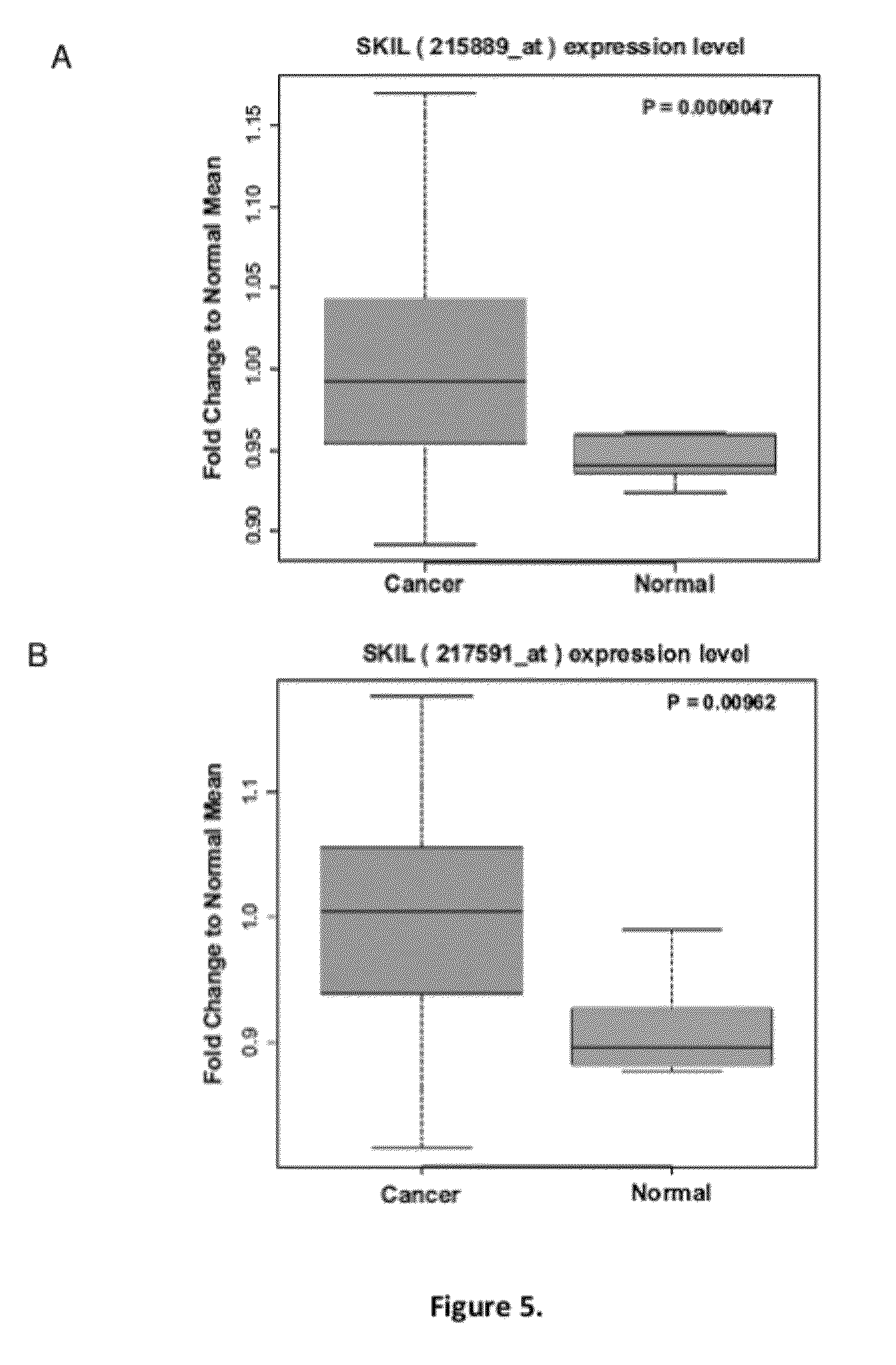Methods of treating ovarian cancer by modulating SnoN
a technology of ovarian cancer and signaling pathway, applied in the field of cancer therapy, can solve the problems of worsening outcome and challenging chemotherapy, and achieve the effects of reducing tumorigenic properties, stable expression of snon, and increasing cell proliferation
- Summary
- Abstract
- Description
- Claims
- Application Information
AI Technical Summary
Problems solved by technology
Method used
Image
Examples
example 1
Increased SnoN DNA Copy Number in Ovarian Carcinomas
[0087]It has been demonstrated that EVI1 (Nanjundan et al., 2007. Amplification of MDS1 / EVI1 and EVI1, located in the 3q26.2 amplicon, is associated with favorable patient prognosis in ovarian cancer. Cancer Res. 67, 3074-3084), the p110a catalytic subunit of phosphatidylinositol-3-kinase (PI3K), and PKCi (Eder et al., 2005. Atypical PKCiota contributes to poor prognosis through loss of apical-basal polarity and cyclin E overexpression in ovarian cancer. Proc. Natl. Acad. Sci. USA 102, 12519-12524; Shayesteh et al., 1999. PIK3CA is implicated as an oncogene in ovarian cancer. Nat. Genet. 21, 99-102) are elevated at the mRNA and protein levels in association with the 3q26 copy number increase in ovarian cancer. Further, reports indicate that SnoN, located adjacent to PKCi, may be a target for gene amplification at 3q26 in squamous-cell carcinomas of the esophagus (Imoto et al., 2001. SNO is a probable target for gene amplification a...
example 2
As2O3 Alters Expression of TGFβ Signaling Mediators in Ovarian Cancer Cells
[0096]As noted above, EVI1 is amplified at 3q26.2 in ovarian cancers, and As2O3 treatment reduces expression of EVI1 in acute promyelocytic leukemia (APL) cells (Shackelford, et al. 2006. Targeted degradation of the AML1 / MDS1 / EVI1 oncoprotein by arsenic trioxide. Cancer Res 66, 11360-11369). To determine whether As2O3 and / or 17-AAG could alter expression of EVI1 and other TGFβ signaling mediators in ovarian cancer cell lines, HEY and OVCA429 cells (both high EVI1 expressing cell lines) were treated for 18 hours with increasing doses of As2O3 and 17-AAG, seen in FIGS. 11 and 12. Interestingly, As2O3 markedly decreased protein levels of several EVI1 forms in both cell lines including MDS1 / EVI1 (which consists of sequences derived from both EVI1 and the MDS1 gene, located telomeric to EVI1; Fears, et al. 1996. Intergenic splicing of MDS1 and EVI1 occurs in normal tissues as well as in myeloid leukemia and produc...
example 3
As2O3 Induces the Degradation of TGFβ Signaling Mediators Via Proteosome-Dependent and -Independent Pathways
[0100]To determine whether the alterations in expression of TGFβ signaling mediators following treatment with As2O3 and 17-AAG were due to proteosome-mediated degradation, combinatorial studies were performed using a proteosome inhibitor (MG132). Generally, the response of HEY and OVCA429 to these drug combinations were similar, seen in FIGS. 16 and 17. Both EVI1 and EVI1Del190-515 protein expression were reduced with 5 μM As2O3 while MDS1 / EVI1 remained unchanged supporting previously reported data in murine leukemia cells, whereas MDS1 was insensitive to the effects of As2O3, seen in FIG. 16 (Shackelford, et al. 2006. Targeted degradation of the AML1 / MDS1 / EVI1 oncoprotein by arsenic trioxide. Cancer Res 66, 11360-11369). Interestingly, the reduction of EVI1 and EVI1Del190-515 expression with As2O3 was recovered with the proteosome inhibitor MG132, suggesting that As2O3-induce...
PUM
| Property | Measurement | Unit |
|---|---|---|
| time | aaaaa | aaaaa |
| time | aaaaa | aaaaa |
| time | aaaaa | aaaaa |
Abstract
Description
Claims
Application Information
 Login to View More
Login to View More - R&D
- Intellectual Property
- Life Sciences
- Materials
- Tech Scout
- Unparalleled Data Quality
- Higher Quality Content
- 60% Fewer Hallucinations
Browse by: Latest US Patents, China's latest patents, Technical Efficacy Thesaurus, Application Domain, Technology Topic, Popular Technical Reports.
© 2025 PatSnap. All rights reserved.Legal|Privacy policy|Modern Slavery Act Transparency Statement|Sitemap|About US| Contact US: help@patsnap.com



